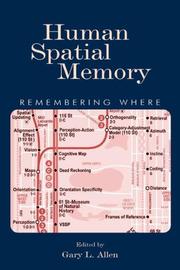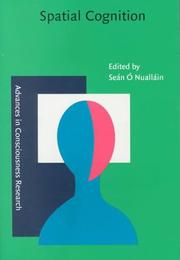| Listing 1 - 10 of 119 | << page >> |
Sort by
|

ISBN: 113800376X 1410609987 9781410609984 9780805842180 0805842187 0805842187 9781135635084 9781135635121 9781135635138 9780415648394 Year: 2004 Publisher: Mahwah, N.J. Lawrence Erlbaum Associates
Abstract | Keywords | Export | Availability | Bookmark
 Loading...
Loading...Choose an application
- Reference Manager
- EndNote
- RefWorks (Direct export to RefWorks)
The chapters in Human Spatial Memory: Remembering Where present a fascinating picture of an everyday aspect of mental life that is as intriguing to people outside of academia as it is to scientists studying human cognition and behavior. The questions are as old as the study of mind itself: How do we remember where objects are located? How do we remember where we are in relation to other places? What is the origin and developmental course of spatial memory? What neural structures are involved in remembering where? How do we come to understand scaled-down versions of places as symbolic re
Space perception --- Spatial behavior --- Spatial ability --- Ability --- Behavior, Spatial --- Proxemic behavior --- Space behavior --- Spatially-oriented behavior --- Psychology --- Space and time
Book
ISBN: 1493999486 1493999478 Year: 2020 Publisher: New York, NY : Springer US : Imprint: Humana,
Abstract | Keywords | Export | Availability | Bookmark
 Loading...
Loading...Choose an application
- Reference Manager
- EndNote
- RefWorks (Direct export to RefWorks)
This volume looks at the latest research techniques to study the interaction of visual spatial learning and attention guidance with behavioral, psychophysiological, and imaging methods. Part One (behavioral methods) focuses on different paradigms of visual search like visual foraging and contextual cueing, and also methods like feature distribution analysis and search in virtual reality. Part Two (psychophysiological methods) integrates innovative uses of classical potential changes like the CDA and N2pc, with multivariate analysis methods and multi-method designs. Part Three (functional imaging) covers lesion-behavior mapping, retinotopic and grid cell mapping methods for human fMRI, as well as functional registration by hyperalignment and simultaneous eye-tracking and fMRI. In Neuromethods series style, chapters include the kind of detail and key advice from the specialists needed to get successful results in your laboratory. Cutting-edge and comprehensive, Spatial Learning and Attention Guidance is a valuable resource for all researchers and scientists who are interested in learning more about the relationship between attention and memory.
Spatial behavior. --- Behavior, Spatial --- Proxemic behavior --- Space behavior --- Spatially-oriented behavior --- Psychology --- Space and time --- Neurosciences. --- Neuroscience. --- Neural sciences --- Neurological sciences --- Neuroscience --- Medical sciences --- Nervous system
Book
ISBN: 131665124X 1108685366 1107154987 1108696295 9781108685368 9781316651247 9781107154988 9781316607077 1316607070 Year: 2018 Publisher: Cambridge : Cambridge University Press,
Abstract | Keywords | Export | Availability | Bookmark
 Loading...
Loading...Choose an application
- Reference Manager
- EndNote
- RefWorks (Direct export to RefWorks)
Our experience of the world is influenced by numerous spatial biases, most of which influence us without our being aware of them. These biases are related to illusions and asymmetries in our perception of space, relationships between space and other qualities, dynamics of moving objects, dynamics of scene configuration, and dynamics related to perception and action. Consideration of these biases provides insight into how we perceive, remember, and navigate space, as well as how we interact with objects and people in space. This volume introduces and reviews numerous spatial biases, and provides descriptions and examples of each bias. The contributors discuss historical and current theories for many biases, and for some biases, provide new explanatory theories. Providing a 'one-stop shop' for information on such a key aspect of our experience in the world, this volume will interest anyone curious about our understanding of space.
Space perception. --- Spatial behavior. --- Cognition. --- Psychology --- Behavior, Spatial --- Proxemic behavior --- Space behavior --- Spatially-oriented behavior --- Space and time --- Spatial perception --- Perception --- Spatial behavior --- Figure-ground perception --- Geographical perception
Book
ISBN: 9781844721672 9780203847749 1844721671 Year: 2010 Volume: 63 Publisher: London Routledge
Abstract | Keywords | Export | Availability | Bookmark
 Loading...
Loading...Choose an application
- Reference Manager
- EndNote
- RefWorks (Direct export to RefWorks)
This study critically analyses the elusive concept of Europeanization as a decision-making process with particular governing logics that both support and, paradoxically undermine the 'European political project'. Serving as a valuable reference for academic and graduate audiences in political science, international and European studies; this book offers an incisive empirically grounded appraisal of the unseen policy dynamics at work in the European Union of the 21st century.
International relations. Foreign policy --- European Union --- Regionalism --- Central-local government relations --- Spatial behavior --- Spatial behavior. --- Behavior, Spatial --- Proxemic behavior --- Space behavior --- Spatially-oriented behavior --- Psychology --- Space and time --- Regionalism - European Union countries --- Central-local government relations - European Union countries

ISBN: 1576750159 9786613307248 1283307243 1605096237 9781605096230 Year: 1997 Publisher: San Francisco : Berrett-Koehler Publishers,
Abstract | Keywords | Export | Availability | Bookmark
 Loading...
Loading...Choose an application
- Reference Manager
- EndNote
- RefWorks (Direct export to RefWorks)
Open Space Technology (OST) is an effective, economical, fast, and easily repeatable strategy for organizing meetings of between 5 and 1,000 participants. First developed in 1984, it has now been used around the world with all types of organizations including corporations, community groups, government agencies, schools, and churches. OST produces better meetings and helps groups achieve such organizational goals as self-managed work groups, distributed leadership, and utilizing diversity quickly and without training. In Expanding Our Now, OST creator Harrison Owen offers numerous examples to illustrate the evolution of OST and explores what it is, how it developed as a process for meeting management, and how and why it works all over the world, for groups of all sizes dealing with a vast range of issues. Owen shows how OST can move organizations to higher levels of performance, without elaborate training or professional facilitators.
Group decision-making. --- Spatial behavior. --- Group decision making --- Spatial behavior --- E-books --- Group decision making. --- Behavior, Spatial --- Proxemic behavior --- Space behavior --- Spatially-oriented behavior --- Psychology --- Space and time --- Collective decision making --- Decision-making, Group --- Decision making
Book
ISBN: 0124479804 Year: 1981 Publisher: New York (N.Y.): Academic press
Abstract | Keywords | Export | Availability | Bookmark
 Loading...
Loading...Choose an application
- Reference Manager
- EndNote
- RefWorks (Direct export to RefWorks)
Developmental psychology --- Spatial behavior --- 159.922.2 --- 159.922.2 Ecologische psychologie --- Ecologische psychologie --- Behavior, Spatial --- Proxemic behavior --- Space behavior --- Spatially-oriented behavior --- Psychology --- Space and time --- Development (Psychology) --- Developmental psychobiology --- Life cycle, Human
Book
ISBN: 067474487X 0674735773 9780674735774 9780674863217 0674863216 9780674744875 Year: 2014 Publisher: Cambridge, Massachusetts
Abstract | Keywords | Export | Availability | Bookmark
 Loading...
Loading...Choose an application
- Reference Manager
- EndNote
- RefWorks (Direct export to RefWorks)
Knowing where things are seems effortless. Yet our brains devote tremendous computational power to figuring out the simplest details about spatial relationships. Going to the grocery store or finding our cell phone requires sleuthing and coordination across different sensory and motor domains. Making Space traces this mental detective work to explain how the brain creates our sense of location. But it goes further, to make the case that spatial processing permeates all our cognitive abilities, and that the brain’s systems for thinking about space may be the systems of thought itself. Our senses measure energy in the form of light, sound, and pressure on the skin, and our brains evaluate these measurements to make inferences about objects and boundaries. Jennifer Groh describes how eyes detect electromagnetic radiation, how the brain can locate sounds by measuring differences of less than one one-thousandth of a second in how long they take to reach each ear, and how the ear’s balance organs help us monitor body posture and movement. The brain synthesizes all this neural information so that we can navigate three-dimensional space. But the brain’s work doesn’t end there. Spatial representations do double duty in aiding memory and reasoning. This is why it is harder to remember how to get somewhere if someone else is driving, and why, if we set out to do something and forget what it was, returning to the place we started can jog our memory. In making space the brain uses powers we did not know we have.
Space perception. --- Spatial behavior. --- Cognition. --- Psychology --- Behavior, Spatial --- Proxemic behavior --- Space behavior --- Spatially-oriented behavior --- Space and time --- Spatial perception --- Perception --- Spatial behavior --- Figure-ground perception --- Geographical perception --- Affective and dynamic functions --- Cognitive psychology

ISBN: 0804780234 0585457794 9780585457796 9780804732925 0804732922 0804732930 9780804780230 Year: 2001 Publisher: Stanford, Calif. : Stanford University Press,
Abstract | Keywords | Export | Availability | Bookmark
 Loading...
Loading...Choose an application
- Reference Manager
- EndNote
- RefWorks (Direct export to RefWorks)
This book writes itself off the guide map of familiar literary forms and melts down conceptual barriers, offering a new kind of reading and thinking experience as it tells the life and travel stories of fascinating women and examines women’s physical mobility in a culture of gendered, postcolonial space that restricts their movement. Straddling the divide between fiction and scholarship, it combines fictional narrative, contemplation, theoretical thinking, scholarly discussion, and interviews. The book examines and crosses boundaries on various ontological levels—between genders, languages, historical epochs, and literary genres—as it questions reality, identity, knowledge, culture, truth, and mind. While openly confronting the author’s location in Israel, the book looks at women’s ability to take themselves from place to place, viewing space and spatial freedom as deeply gendered in modern Western cultures. From this perspective, “home” is imagined as a protective holding space for one gender, and girls are systematically deskilled for spatial competence. The author tells of women whose lives embody a powerful project of travel, realizing exceptional degrees of independence, and also tells of women who refrain from driving, a major contemporary tool of autonomous movement. The book imagines a movement-nurturing space that subverts the confining construct of home. From this nonexistent yet tangibly welcoming home space, the “glass corridors” of home—analogous to the “glass ceiling” of professional life—can be brought into full view and denaturalized. This cannot be accomplished, however, without a compelling, painful look at the patriarchal, colonial, and militarized structures underpinning all Western travel, women’s emancipatory journeys included—a look influenced by the still-colonial structure of the author’s Israeli placement.
Women --- Spatial behavior. --- Social mobility. --- Women travelers. --- Travelers, Women --- Travelers --- Mobility, Social --- Sociology --- Behavior, Spatial --- Proxemic behavior --- Space behavior --- Spatially-oriented behavior --- Psychology --- Space and time --- Feminism --- Social conditions.

ISBN: 1282160699 9786612160691 9027295840 9789027295842 9781588114785 1588114783 1588114783 9027233128 Year: 2004 Publisher: Amsterdam Philadelphia, PA J. Benjamins
Abstract | Keywords | Export | Availability | Bookmark
 Loading...
Loading...Choose an application
- Reference Manager
- EndNote
- RefWorks (Direct export to RefWorks)
Organizational sociology --- Spatial behavior. --- SOCIAL SCIENCE --- Sociology / General --- Social Change --- Sociology & Social History --- Social Sciences --- Behavior, Spatial --- Proxemic behavior --- Space behavior --- Spatially-oriented behavior --- Psychology --- Space and time --- Organization (Sociology) --- Organization theory --- Sociology of organizations --- Sociology --- Bureaucracy --- Philosophy.

ISBN: 128225507X 9786612255076 0585461856 9027299889 9780585461854 1556198426 9781556198427 1556198426 9781282255074 6612255072 9789027299888 9027251460 9789027251466 Year: 2000 Volume: 26 Publisher: Amsterdam Philadelphia John Benjamins Pub.
Abstract | Keywords | Export | Availability | Bookmark
 Loading...
Loading...Choose an application
- Reference Manager
- EndNote
- RefWorks (Direct export to RefWorks)
Spatial behavior --- Space perception --- Personal space --- Human territoriality --- Interpersonal relations --- Space --- Behavior, Spatial --- Proxemic behavior --- Space behavior --- Spatially-oriented behavior --- Psychology --- Space and time --- Comportement spatial --- Perception spatiale --- Espace personnel --- Cognitive psychology --- Theory of knowledge --- Psycholinguistics
| Listing 1 - 10 of 119 | << page >> |
Sort by
|

 Search
Search Feedback
Feedback About
About Help
Help News
News